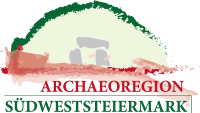
The impressive burial mound (tumulus) not far from the Höchkiegerl estate is one of the largest preserved Roman burial mounds in the Lassnitz river Valley. Already in the 1930s, the Gams priest Pitter undertook excavations with students whose finds and records have unfortunately disappeared.
In the year 2000 a new investigation was carried out by the Federal Office for the Protection of Monuments, which uncovered an approximately square burial chamber made of stones in the center of the mound. The burial chamber had an entrance formed by two dry stone walls. This specific grave form is called a dromos grave. At the original entrance to the tomb, a monumental stone block made of feldspar was encountered, the top of which had a rectangular chiseled depression that served to fix a stone (probably marble) funerary stela in ancient times. The main burial (a cremation), of which few remains had survived, dates to approximately the 2nd century A.D. The finds material consists of a garment clasp (so-called fibula) made of bronze, further some fragments of pots, plates and bowls made of ceramics.
In the access corridor (dromos) of the burial mound, traces of a post-burial from the 4th century were uncovered. After the archaeological investigations, the tumulus was filled in again and now has imposing dimensions of a good 33 by 27 m. Not far from the large burial mound there is another, much smaller mound, the existence of which suggests the burial area (cemetery) of a Roman-period family.
The stone block (stela base) recovered in the course of the excavation can be seen today in the park next to the municipal office in Frauental.
Text: Mag. Andreas Bernhard

